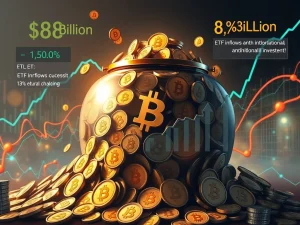Dominant BlackRock Bitcoin ETF Defies Sell-Offs, Captures Unstoppable 50% Market Share

In a dramatic turn of events in the cryptocurrency market, BlackRock’s Bitcoin ETF, known as IBIT, has achieved a monumental milestone. Despite experiencing three consecutive days of significant sell-offs across the broader crypto landscape, IBIT has not only weathered the storm but has also remarkably surpassed a 50% market share in the Bitcoin ETF arena. This dominant performance underscores the unwavering investor confidence in BlackRock’s offering and the underlying resilience of Bitcoin itself. But what does this surge in market share really mean, especially when juxtaposed with recent ETF outflows? Let’s delve into the details to understand the full picture.
Decoding BlackRock’s Bitcoin ETF Market Share Triumph
BlackRock’s iShares Bitcoin Trust (IBIT) has rapidly become a behemoth in the Bitcoin ETF space. Surpassing 50% market share is no small feat, especially considering the relatively short time frame since these ETFs were first approved. This achievement signifies a massive influx of capital into IBIT, indicating strong investor preference. But how did BlackRock manage to capture such a significant portion of the market so quickly? Several factors likely contributed to this impressive growth:
- Brand Trust and Reputation: BlackRock is a globally recognized and trusted asset manager. Their entry into the Bitcoin ETF market brought a level of legitimacy and comfort to institutional and retail investors alike.
- Early Mover Advantage: While not the only Bitcoin ETF available, BlackRock was among the first wave of issuers, allowing them to capitalize on initial investor enthusiasm and demand.
- Efficient ETF Structure: The specific structure and operational efficiency of IBIT might be appealing to investors, potentially offering lower fees or better tracking compared to competitors.
- Aggressive Marketing and Distribution: BlackRock’s extensive distribution network and marketing capabilities likely played a crucial role in reaching a wider investor base and highlighting the benefits of their Bitcoin ETF.
This market share dominance isn’t just a number; it represents a significant shift in how investors are accessing Bitcoin exposure. Traditional investment giants like BlackRock legitimizing Bitcoin through ETFs are paving the way for wider mainstream adoption.
Navigating the Recent Bitcoin ETF Outflows: A Temporary Setback?
While BlackRock’s IBIT is celebrating its market share victory, it’s crucial to acknowledge the broader context of recent ETF outflows. Over the past three days, we’ve witnessed a notable outflow from Bitcoin ETFs overall. This raises a critical question: If Bitcoin ETFs are experiencing outflows, how can BlackRock’s market share be increasing?
The answer lies in understanding the dynamics of market share. Even with overall outflows, if BlackRock’s ETF is experiencing lesser outflows compared to its competitors, or even inflows while others see outflows, its market share will naturally increase. Think of it like this:
| Bitcoin ETF Provider | Previous Market Share | Current Market Share | Outflow/Inflow |
|---|---|---|---|
| BlackRock (IBIT) | 45% | 51% | – Small Outflow |
| Competitor A | 30% | 25% | – Large Outflow |
| Competitor B | 25% | 24% | – Moderate Outflow |
In this hypothetical scenario, even if IBIT experiences some outflows, the larger outflows from competitors result in IBIT gaining a larger slice of a potentially shrinking pie. This highlights the relative strength and investor preference for BlackRock’s Bitcoin ETF even during market downturns.
Bitcoin Price Resilience: Weathering the Storm
Amidst the ETF flow fluctuations and broader market concerns, the Bitcoin price has demonstrated remarkable resilience. While there have been price corrections and volatility, Bitcoin has largely held its ground, refusing to succumb to a major crash. This price stability, in the face of potential negative pressures, is a testament to the underlying strength of the Bitcoin network and continued long-term belief in its value proposition.
Several factors contribute to this Bitcoin price resilience:
- Strong Fundamentals: Bitcoin’s core principles of decentralization, limited supply, and secure blockchain technology remain intact and continue to attract believers.
- Growing Institutional Adoption: Beyond ETFs, increasing institutional interest in Bitcoin as a store of value and portfolio diversifier provides a strong base of demand.
- Global Macroeconomic Factors: In times of economic uncertainty, Bitcoin is increasingly seen as a hedge against inflation and traditional market volatility.
- Hodler Mentality: A significant portion of Bitcoin holders are long-term believers who are less likely to sell during short-term price fluctuations, creating a strong base of support.
This resilience in Bitcoin price, coupled with BlackRock’s ETF success, paints a picture of a maturing market where institutional players and long-term investors are playing an increasingly dominant role.
The Impact of Sell-offs: Opportunity or Cause for Concern?
The recent sell-offs in the cryptocurrency market are a natural part of the market cycle. Volatility is inherent in crypto assets, and periods of correction are expected after periods of rapid growth. But are these sell-offs a cause for concern, or do they present an opportunity?
For long-term investors, sell-offs can be viewed as buying opportunities. Lower prices allow for accumulation of assets at a discount. Furthermore, sell-offs can help to flush out excessive speculation and leverage from the market, creating a healthier foundation for future growth.
However, it’s crucial to acknowledge the potential risks associated with sell-offs:
- Market Sentiment Shift: Prolonged or severe sell-offs can negatively impact market sentiment, leading to further downward pressure.
- Liquidation Cascades: In highly leveraged markets, sell-offs can trigger liquidation cascades, exacerbating price declines.
- Economic Uncertainty: Broader economic downturns can amplify the impact of sell-offs in risk assets like cryptocurrencies.
Navigating these sell-offs requires a balanced approach. Understanding market cycles, managing risk effectively, and focusing on long-term fundamentals are key to weathering periods of volatility and capitalizing on potential opportunities.
Looking Ahead: The Future of Bitcoin ETFs and Market Dominance
BlackRock’s Bitcoin ETF achieving a 50% market share is a landmark event, but the story is far from over. The Bitcoin ETF market is still relatively young, and competition is likely to intensify. What does the future hold for Bitcoin ETFs and market dominance in this space?
Here are some key trends and predictions:
- Increased Competition: More asset managers are likely to enter the Bitcoin ETF market, intensifying competition for market share.
- Fee Compression: Competition may drive down ETF fees, benefiting investors but potentially impacting profitability for issuers.
- Product Innovation: We may see more specialized crypto ETFs emerge, focusing on different sectors, strategies, or risk profiles within the crypto ecosystem.
- Regulatory Developments: Evolving regulations will continue to shape the Bitcoin ETF landscape, impacting product development and market access.
- Mainstream Adoption: Bitcoin ETFs are expected to play a crucial role in further mainstream adoption of Bitcoin and cryptocurrencies by providing easier and more regulated access for a wider range of investors.
In conclusion, BlackRock’s Bitcoin ETF surpassing 50% market share is a powerful signal of institutional confidence in Bitcoin and the growing maturity of the crypto market. While short-term sell-offs and volatility are inevitable, the long-term trajectory points towards continued growth and mainstream integration of Bitcoin and crypto assets. Staying informed, understanding market dynamics, and focusing on long-term value will be crucial for navigating this exciting and evolving landscape.









